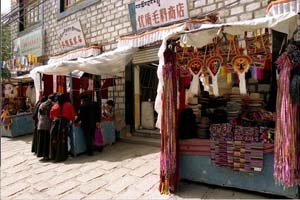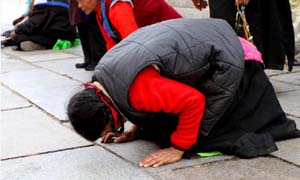Barkhor Street
Rather than being one street, Barkhor is actually a complex of streets and a square in what is the oldest part of the city of Lhasa, capital of Tibet. The street originated in the clockwise route which Buddhist pilgrim used to circumambulate Jokhang Temple, Tibet's most holy. With thousands of pilgrims treading this route every day for over a thousand years the street became well defined.
Over time side streets, lanes and alleys were added and the Barkhor Square. Today the pilgrims are still circumambulating the temple and the surrounding area has become a major tourist destination. This is the best place to see Lhasa's traditional Tibetan architecture and the streets are lined by small shops selling Tibetan souvenirs such as prayer wheels, the tradition Tibetan long-sleeve 'chuba', Tibetan knives, jade jewellery, Buddhist statues and other religious artefacts. It is also the place to find 'Thangka' or Tibetan scroll paintings with themes of religion, history, literature, etc.

Alongside the many colourful shops are many small, cheap restaurants specialising in authentic Tibetan food. In the unlikely event that the restaurants have a menu at all, it will be in Tibetan only so unless you read Tibetan you are going to have to point at what the other diners are eating and hope for the best! While Tibet may never be prized for its exquisite cuisine, no trip to Tibet would be complete without at least trying tsamba (the Tibetan staple made by mixing ground barley flour with salty butter tea till it forms a dough), yak meat and butter tea. Contrary to many people's expectations, few Tibetan's are vegetarian. That would be difficult in a land with so few vegetables!
The area also has a number of small temples to complement the Jokhang and in the south-eastern corner is Tibet's Muslim area where you can find many more small shops and restaurants serving Muslim style noodle dishes, kebabs and dried fruits.

When in the main Barkhor Street with its pilgrims it is important to remember to walk in a clockwise direction. The 'street' is about one kilometre long. But also, take time out to do some people watching. Many of these pilgrims have walked hundreds of miles to be here, some prostrating themselves every few feet. For them it is a profound statement of faith and one of the most important rites in a Tibetan Buddhist's life – on a scale with the Muslims' pilgrimage to Mecca.
Whether you are there to take part in the religious rite, to do a bit of souvenir shopping, to eat Tibetan or Chinese Muslim food or just for simple site-seeing, the Barkhor Street area is one of the most fascinating and colourful places in all of Tibet.
Interested in this site? Just take a Tibet tour with Access Tibet Tour to see it!
Rather than being one street, Barkhor is actually a complex of streets and a square in what is the oldest part of the city of Lhasa, capital of Tibet. The street originated in the clockwise route which Buddhist pilgrim used to circumambulate Jokhang Temple, Tibet's most holy. With thousands of pilgrims treading this route every day for over a thousand years the street became well defined.
Over time side streets, lanes and alleys were added and the Barkhor Square. Today the pilgrims are still circumambulating the temple and the surrounding area has become a major tourist destination. This is the best place to see Lhasa's traditional Tibetan architecture and the streets are lined by small shops selling Tibetan souvenirs such as prayer wheels, the tradition Tibetan long-sleeve 'chuba', Tibetan knives, jade jewellery, Buddhist statues and other religious artefacts. It is also the place to find 'Thangka' or Tibetan scroll paintings with themes of religion, history, literature, etc.

Alongside the many colourful shops are many small, cheap restaurants specialising in authentic Tibetan food. In the unlikely event that the restaurants have a menu at all, it will be in Tibetan only so unless you read Tibetan you are going to have to point at what the other diners are eating and hope for the best! While Tibet may never be prized for its exquisite cuisine, no trip to Tibet would be complete without at least trying tsamba (the Tibetan staple made by mixing ground barley flour with salty butter tea till it forms a dough), yak meat and butter tea. Contrary to many people's expectations, few Tibetan's are vegetarian. That would be difficult in a land with so few vegetables!
The area also has a number of small temples to complement the Jokhang and in the south-eastern corner is Tibet's Muslim area where you can find many more small shops and restaurants serving Muslim style noodle dishes, kebabs and dried fruits.

When in the main Barkhor Street with its pilgrims it is important to remember to walk in a clockwise direction. The 'street' is about one kilometre long. But also, take time out to do some people watching. Many of these pilgrims have walked hundreds of miles to be here, some prostrating themselves every few feet. For them it is a profound statement of faith and one of the most important rites in a Tibetan Buddhist's life – on a scale with the Muslims' pilgrimage to Mecca.
Whether you are there to take part in the religious rite, to do a bit of souvenir shopping, to eat Tibetan or Chinese Muslim food or just for simple site-seeing, the Barkhor Street area is one of the most fascinating and colourful places in all of Tibet.
Interested in this site? Just take a Tibet tour with Access Tibet Tour to see it!